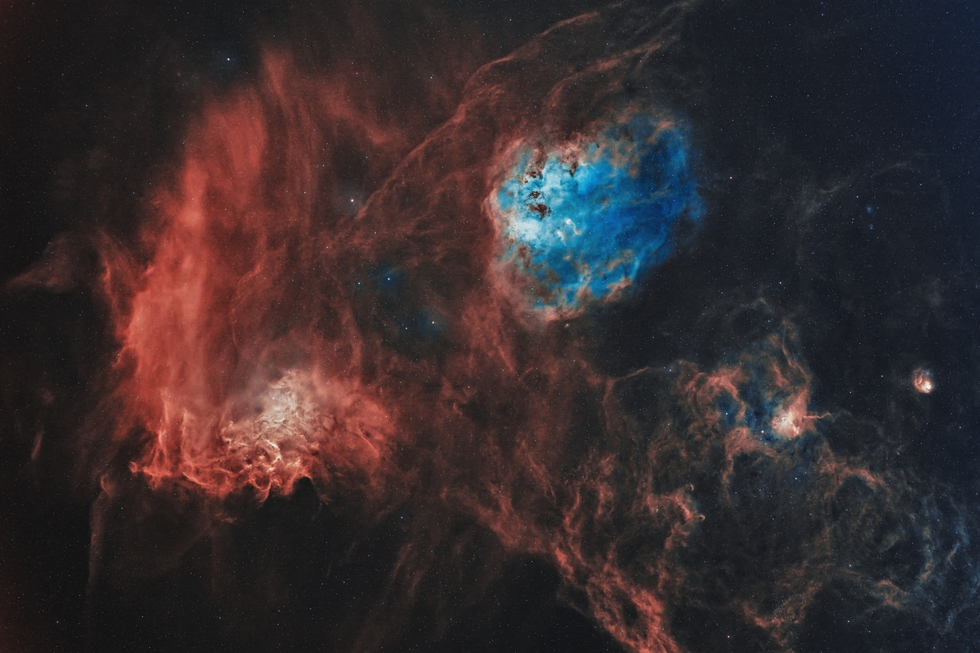Auriga Nebulae
Auriga Nebulae
Auriga is a constellation rich in various types of nebulae, each with its own unique characteristics. Here are some notable nebulae in Auriga, including NGC 1931:
1. **Flaming Star Nebula (IC 405):** This emission/reflection nebula is one of the prominent features in Auriga. It exhibits a combination of blue reflection nebula and red emission nebula, named for its vivid reddish hue. IC 405 is illuminated by the star AE Aurigae.
2. **Flaming Star Cluster (NGC 1893):** Located near IC 405, this open star cluster is associated with the nebula. It comprises young stars formed from the surrounding gas and dust.
3. **Tadpole Nebula (IC 410):** IC 410 is an emission nebula known for its tadpole-like appearance. It's an active star-forming region with hot, young stars illuminating the surrounding gas clouds.
4. **Spider Nebula (IC 417):** IC 417 is another emission nebula in Auriga. It derives its name from its resemblance to a spider. This region hosts young, massive stars that excite the surrounding hydrogen gas, creating a beautiful celestial sight.
5. **NGC 1931:** This bright emission nebula is associated with a young star cluster in Auriga. It comprises a glowing cloud of gas and dust illuminated by young, hot stars within the cluster, particularly HD 45320. The radiation and stellar winds from these stars shape the nebula, making it an intriguing subject for studying star formation.
These nebulae in Auriga represent regions of active star formation, where the interplay between young, massive stars and the surrounding gas and dust creates stunning cosmic landscapes. They offer astronomers valuable insights into the lifecycle of stars, the dynamics of nebulae, and the chemistry of the interstellar medium within our galaxy.
1. **Flaming Star Nebula (IC 405):** This emission/reflection nebula is one of the prominent features in Auriga. It exhibits a combination of blue reflection nebula and red emission nebula, named for its vivid reddish hue. IC 405 is illuminated by the star AE Aurigae.
2. **Flaming Star Cluster (NGC 1893):** Located near IC 405, this open star cluster is associated with the nebula. It comprises young stars formed from the surrounding gas and dust.
3. **Tadpole Nebula (IC 410):** IC 410 is an emission nebula known for its tadpole-like appearance. It's an active star-forming region with hot, young stars illuminating the surrounding gas clouds.
4. **Spider Nebula (IC 417):** IC 417 is another emission nebula in Auriga. It derives its name from its resemblance to a spider. This region hosts young, massive stars that excite the surrounding hydrogen gas, creating a beautiful celestial sight.
5. **NGC 1931:** This bright emission nebula is associated with a young star cluster in Auriga. It comprises a glowing cloud of gas and dust illuminated by young, hot stars within the cluster, particularly HD 45320. The radiation and stellar winds from these stars shape the nebula, making it an intriguing subject for studying star formation.
These nebulae in Auriga represent regions of active star formation, where the interplay between young, massive stars and the surrounding gas and dust creates stunning cosmic landscapes. They offer astronomers valuable insights into the lifecycle of stars, the dynamics of nebulae, and the chemistry of the interstellar medium within our galaxy.
SPECIFICATIONS
Telescope
SPA-1CMOS | Takahashi FSQ 106ED
Camera
QHY 600M
Location
IC Astronomy Observatory, Spain
Date of observation
March 19th, Dec 19,20,21, 2023
Filters
SHO
Processing
Astro Pixel Processor, Pixinsight, Photoshop
Credits
Robert G. Lyons/Telescope Live



